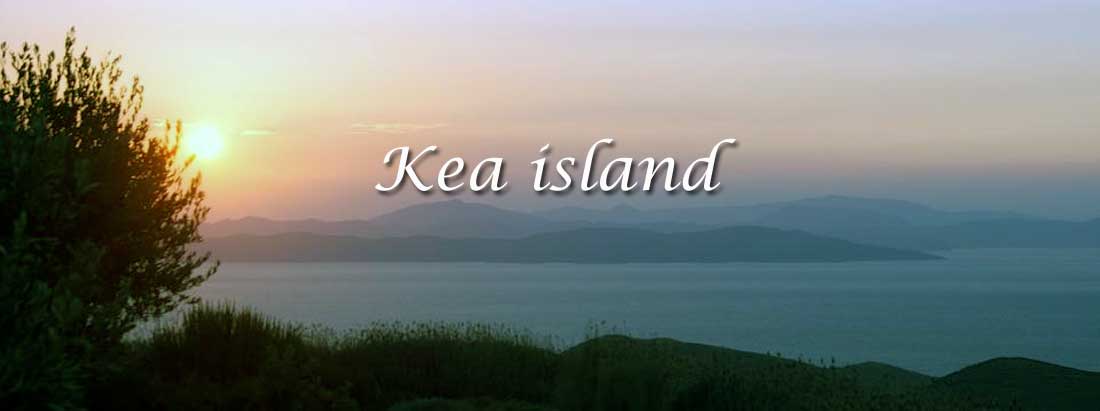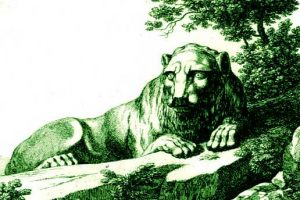Information about the island of Kea in Greece
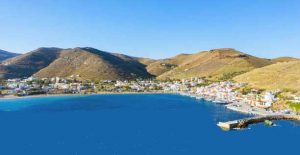
The island in itself is a charming little paradise and it is still a very genuine place to visit. There are a few taverns and cafes, and the pace is slow and comfortable. Kea is an excellent alternative for those who want to get away from the busier islands, but still don’t want the total quiet. The islanders here live mainly off agriculture, stock-breeding and fishing.
Kea is a peculiar case of an island. Partly wronged because as close to the coast of Attica, as an easy weekend destination, it is underestimated by many, as something that is not an island or as much an island as others.
If you go for a few days, you will go to the essentials. And most are stacked on the same beaches, the same taverns. But all this is not a one-way street. As is the case for all the islands of Greece, if you have the appetite to look for something more, if you have the appetite to see what others do not see, you will discover on this island small well-hidden personal paradises.
Kea is the nearest Cycladic island to Athens has its hidden beauties and to discover them you have to walk in the countryside looking for old cobbled streets, oak forests, secluded stone houses, tower remains, with most important the tower in Agia Marina, which is also one of the tallest surviving monuments of the Mediterranean , monuments of the Middle Byzantine period such as the monastery of Agia Anna, the church of Agios Apostolos in Elies Katomeria and the church of Agios Panteleimon in the area Nero.
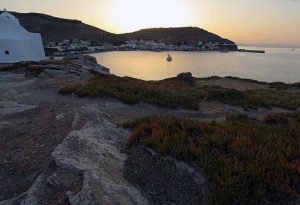
Mythology
According to Greek mythology, the Cyclades islands, including Kea, were formed from the transformed bodies of giants slain by the god Zeus during the Titanomachy. The giants were cast into the sea, and their petrified bodies created the scattered islands of the Cyclades.
Kea is said to be the birthplace of Aristaeus, a minor god in Greek mythology. Aristaeus was the son of Apollo and Cyrene and was known as the protector of beekeeping and cheese-making. Legend has it that he introduced the art of beekeeping to humanity and taught people how to gather honey.
In ancient times, Kea was known for its religious practices and the worship of various deities. The island had sanctuaries dedicated to the worship of Apollo, Athena, and Artemis. These sanctuaries were important religious centers where rituals, sacrifices, and celebrations took place.
Greek mythology often speaks of nymphs, nature spirits associated with different natural elements. Kea was believed to be home to various nymphs and Nereids, who were sea nymphs. These nymphs were often depicted as beautiful maidens associated with water sources, forests, and mountains.
SLike many Greek islands, Kea has its share of mythical sea monsters and heroic tales. In the story of Jason and the Argonauts, Kea is mentioned as one of the stops made by the heroes during their quest for the Golden Fleece. It is said that the Argonauts landed on Kea and fought against the notorious sea monster Scylla, who inhabited the waters around the island.
History
During the Archaic and Classical periods of ancient Greece, Kea was a prosperous island known for its mining activities. The island was particularly famous for its iron production, and its iron mines supplied materials for the construction of various structures, including the famous Lion of Kea statue, which is now displayed in the Archaeological Museum of Kea.
In the 5th century BCE, Kea participated in the Persian Wars, siding with the Athenians. The island became a member of the Delian League, an alliance led by Athens against the Persian Empire. However, Kea later revolted against Athenian rule in the Peloponnesian War and joined the Spartan-led alliance. Following the defeat of Athens in the war, Kea came under Spartan control.
During the Hellenistic period, Kea was ruled by various Hellenistic kingdoms, including the Macedonian Empire and the Ptolemaic Kingdom of Egypt. In 146 BCE, the island came under Roman rule after the Roman general Lucius Mummius sacked the city of Corinth and incorporated the entire region into the Roman Republic.
In the Byzantine era, Kea, like other Greek islands, faced invasions and raids by various groups, including pirates. The island was frequently attacked by Arab raiders during the 7th and 8th centuries. In the 13th century, Kea came under the control of the Venetians, who fortified the island to protect it against pirate raids.
During the Ottoman period, Kea, like the rest of Greece, was under Ottoman rule for several centuries. The island suffered from pirate attacks and periods of decline. It regained its independence following the Greek War of Independence in the early 19th century.
In more recent history, Kea has developed into a popular tourist destination, known for its beautiful beaches, traditional villages, and archaeological sites. The island’s rich history is evident in its ancient ruins, including temples, fortresses, and the well-preserved Lion of Kea. Kea continues to attract visitors who are interested in exploring its history, enjoying its natural beauty, and experiencing the unique culture of the Cyclades.
Facts about Kea
Location: Kea is situated in the Aegean Sea, approximately 17 kilometers (11 miles) southeast of Athens, the capital city of Greece.
Size and Population: Kea covers an area of about 131 square kilometers (51 square miles) and has a population of around 2,500 permanent residents. However, during the summer months, the population significantly increases due to tourism.
Natural Beauty: Kea is known for its diverse natural landscape, combining rocky hillsides with beautiful sandy beaches. The island offers a peaceful and serene environment, making it an ideal destination for relaxation and nature lovers. Some of the popular beaches on Kea include Koundouros, Otzias, and Gialiskari.
Chora: The main town of Kea is called Chora or Ioulida. It is a traditional Cycladic village characterized by narrow alleys, white-washed houses, and picturesque squares. Chora features charming taverns, cafes, and shops, making it a pleasant place to wander around and enjoy the local atmosphere.
Archaeological Sites: Kea has a rich history dating back to ancient times. Visitors can explore several archaeological sites, including the ancient city of Karthea, which was an important religious and cultural center in antiquity. The Temple of Athena and the ancient theater are among the highlights of Karthea.
Hiking and Nature Trails: Kea is an excellent destination for hiking enthusiasts. The island has a well-marked network of hiking trails that allow visitors to explore its natural beauty and discover hidden gems. The Kea Trails organization has established a variety of routes, showcasing the island’s diverse flora, fauna, and landscapes.
Water Activities: Kea offers opportunities for various water activities such as swimming, snorkeling, and scuba diving. The crystal-clear waters around the island are perfect for exploring the underwater world and observing marine life.
Ferries and Access: Kea is easily accessible by ferry from the port of Lavrio, which is located about 45 kilometers (28 miles) southeast of Athens. The ferry journey takes approximately one hour. Lavrio can be reached by bus or taxi from Athens International Airport or central Athens.
Overall, Kea is a charming and tranquil island that combines natural beauty, historical sites, and traditional Cycladic culture. It offers a relaxing atmosphere away from the bustling crowds, making it an appealing destination for those seeking a peaceful Greek island experience.
Economy
The economy of Kea primarily relies on tourism, agriculture, and fishing. Here are some key aspects of the island’s economy:
-
Tourism: Kea attracts a significant number of tourists, especially during the summer season. The island’s natural beauty, sandy beaches, and traditional villages are the main attractions for visitors. Tourism-related businesses, such as hotels, guesthouses, restaurants, and souvenir shops, contribute significantly to the local economy.
-
Agriculture: Kea has a long tradition of agriculture, and it continues to be an important sector of the economy. The fertile soil and favorable climate support the cultivation of various crops, including olives, grapes, figs, almonds, and vegetables. Local farmers also engage in livestock farming, primarily raising goats and sheep for dairy and meat products.
-
Fishing: Due to its location in the Aegean Sea, fishing has been a traditional occupation on Kea. Local fishermen supply fresh fish and seafood to the island’s restaurants and markets. While fishing may not be a major industry, it plays a role in supporting the local economy and providing livelihoods for some residents.
-
Local Crafts and Products: Kea is known for its local craftsmanship and artisanal products. Traditional crafts like weaving, pottery, and woodwork are still practiced on the island, producing unique handmade items. These products are often sold in local shops and contribute to the cultural heritage of Kea.
-
Services and Small Businesses: Apart from tourism-related services, small businesses play a vital role in Kea’s economy. These include grocery stores, bakeries, cafes, bars, and other services catering to the needs of both residents and visitors. Many locals also operate family-owned businesses, such as guesthouses or taverns, to capitalize on the tourism industry.
It’s important to note that Kea’s economy is influenced by its size and relative proximity to Athens. Many residents of Kea work in Athens and commute to the island on weekends or during the summer season. This interconnection with the mainland provides additional economic opportunities for the local population.
Overall, Kea’s economy revolves around tourism, agriculture, fishing, and local crafts, with a focus on maintaining its natural beauty and traditional character to attract visitors
Villages of Kea
Ioulida (also called Chora)
Ioulida is the capital and main town of Kea. It is perched on a hill and offers panoramic views of the island and the Aegean Sea. The town is known for its narrow alleys, white-washed houses, and traditional architecture. Ioulida also features archaeological sites, such as the ancient city walls and the Lion of Kea statue.
Vourkari
Located on the northeastern coast of Kea, Vourkari is a picturesque fishing village that has developed into a popular tourist destination. It features a small harbor filled with fishing boats, yachts, and waterfront taverns. Vourkari is known for its lively nightlife, art galleries, and boutique shops.
Otzias
Situated on the northern part of the island, Otzias is a coastal village with a beautiful sandy beach. It offers a tranquil atmosphere and is an ideal destination for families and those seeking a relaxing beach vacation. Otzias has a few taverns and accommodations overlooking the sea.
Korissia (or Livadi)
Korissia is the main port of Kea, located on the western coast. It has a long sandy beach lined with taverns, cafes, and bars. Korissia serves as the gateway to the island, welcoming visitors arriving by ferry. The village also features some hotels, shops, and a small archaeological museum.
Pisses
Pisses is a small village located on the southeastern coast of Kea. It offers a sandy beach and crystal-clear waters, making it a popular spot for swimming and sunbathing. Pisses has a few taverns and apartments for visitors.
Koundouros
Koundouros is a coastal village located on the southwestern part of Kea. It features a beautiful bay with sandy beaches and turquoise waters. Koundouros is known for its luxury villas, resorts, and water sports facilities, attracting both tourists and locals seeking a high-end beach experience.
What to see in Kea
Ancient Karthea
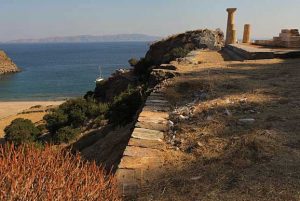
The Town Hall
Impressive neoclassical building with original decoration, has the signature of the architect Ernst Ziller, as well as the neoclassical building that housed the primary school.
Settlement of Agia Irini
Opposite Vourkari you will see the lighthouse of Agios Nikolaos, the first to operate in the Cyclades. Right next door are the remains of an important prehistoric settlement, which was founded during the Late Neolithic period (3300/3200 BC) and was inhabited until the end of the Late Bronze Age (1200/1100 BC).
Panagia Kastriani
The imposing all-white monastery of the patron saint of the island is located southeast of Otzias and is built exactly where the icon of the Virgin Mary was found. Approaching you will see that inside the courtyard there are two churches – the oldest is from 1910 – as well as rooms that accommodate visitors for a token amount. The festival that takes place here on the 15th of August is one of the most important on the island.
Lion of Ioulis
Archaic sculpture carved into a rock “protects” the capital of the island. As the legend says: the island was inhabited by nymphs, until a terrible lion came and chased them away to take the place of Kares, Leleges, Phoenicians, Pelasgians and Ionians.
Archaeological Museum of Ioulis
The museum exhibits are shared on two floors of a building built in 1970. The first floor houses findings of historical times (7th BC-2nd century AD) and the second floor findings of the prehistoric period. Some of the most impressive are the clay statues of female figures from the settlement of Agia Eirini from the 15th century BC. and the sculptures of Karthaia, which are reminiscent of their modern style of ancient Athens.
Enamel factory
Since 1957, when the first factory for the production of enameled utensils in Greece closed, the building is in ruins, although today efforts are being made to function as an exhibition space. This quaint ruined industrial landscape is located 200 meters to the right of the port. Some of his machines are exhibited by the Association of Friends of the Enamel Factory in a municipal area.
What to do in Kea
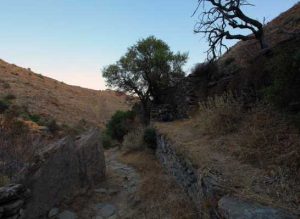
The tour of the -mainly- cobbled paths is enchanting, as walkers cross them through oak forests, admire the beautiful wildflowers, meet traditional stone fountains, and whitewashed, picturesque chapels, ending in either small ornate chapels. . Those who decide to walk them sometimes have the opportunity to “transport” to the distant and fascinating past, as they walk in the footsteps of ancient Keia, since many of the routes were part of the road network that connected the four city-states and have a strong history and archaeological interest.
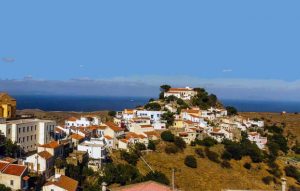
On many of the beaches of Kea there are water sports and beach volley. If you like fishing, you won’t be alone, and there is also a mini golf course.
Go at the monastery of Kastriani for a walk. For believers and unbelievers this walk. The monastery of Kastriani, like all monasteries basically, is strategically located. In one of the northernmost points of Kea, to look fearlessly at the North with the wind hitting it mercilessly almost every day. But its beauty is so eerie, the rocks and coves beneath it are so impressive, such is the serenity in the noise of the air that is really worth the 15 minutes from Otzias.
Beaches
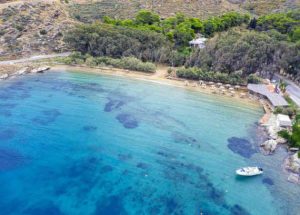
Otzias beach, with a few sunbeds, shallow waters and shade from tamarisk trees along with the sandy but not great beach of Korissia and the large, organized in a part, beach in Poisses are the favourites of the families.
Kundouros beach, dotted with country houses, is full of pebble coves, the sandy Xyla beach is the most exotic of the beaches and Spathi, Sykamia and Kalydonychi, a little more isolated and accessible only by dirt road with crystal waters.
Many beaches are not approached by a simple car. And there are too many of them, especially on the East Side. Psili Ammos with very fine sand, while next to it there is Kalydonichi, with pebbles and green waters.
Below is Agios Filippos where the ravine ends from the mountains of Agios Symeon. The rocky beach of Karthea which is accessible either by the sea or by an ancient path, to reach almost the southernmost part of the island and the beach Stefa, which is completely protected from the North and the “meltemi” ( Summer wind).
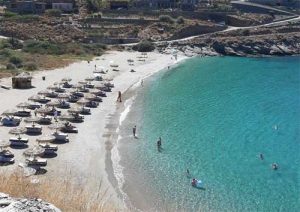
In Vroskopos, Kalogiros and Kalamitsi for their wild beauty. All three are beaches on the west side, between Xylas and Koundouros. Beaches that are difficult to reach even with a good car. But it is precisely these “deceptive” beaches of the west and east (Kalydonichi, Sykamia, Kaliskia) that make Jia stand out so much. A beauty enjoyed by those who approach them by boat and sailboat, a beauty that they have not yet managed to step on with a bar and houses around.
Nightlife
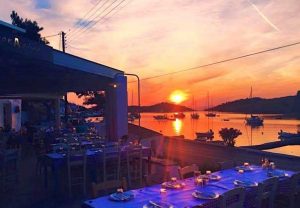
The centre of nightlife in Kea is in Vourkari, the small port of fishermen and sailors, in the wider bay of Korrisia, it gathers the tourists at night. You start with fruitful cocktails in Afro bar, it is a narrow bar, but it is an ideal first stop for a pleasant night on the island.
Coca is now one of the most historic bars where you can have a drink, with patrons not giving up, even in the morning. At Vourkari as well the bar Vinyl has dominated for many years. It is the place that everyone who has ever visited Jia has gone through.
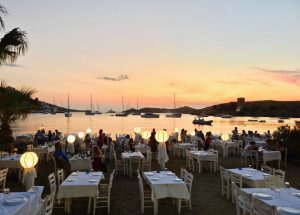
At Zeus Faber opened a few years ago, it was the alternative to the classic values of the island. It is now the established hangout for the first drinks of anyone who decides to go to Vourkari for a drink. Not that he has to go anywhere else. Nice cocktails, nice music in a bar that you hope to have every day near you and in the city. On its terrace for more relaxed, in its inner bars if you have the appetite to dance a little. Potis has made a very nice shop that is very likely to bake you every night to spend it from 10 to 03:00 with his drinks.
Local cuisine of Kea
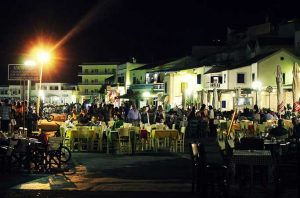
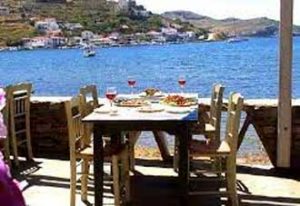
At the “Enea Kores” for the most beautiful fish of the island. Many claim this title but the chef has set up one of the most beautiful restaurants on the island and the fish he serves are incomparable. From brood and octopus to fresh fish and lobster spaghetti. Its tables overlook the bay of Vourkari and if you catch one of the tables by the sea you will have the opportunity to spend one of the most idyllic afternoons or evenings on the island. The icing on the cake is the fantastic orange pie with ice cream after the meal.
Shopping
There are not many tacky souvenir shops on Kea, in stead, you’ll find a lot of handmade ceramics, carved wood and leatherwear. Before leaving the island, make a stop at the shops of the port to get the established souvenirs and local delicacies, such as pastries, sausages and jams, so that when you return to the city you have the taste of the island with you.
Getting Around
There is a local bus which will take you to the main villages. Most Athenians take their cars with them, you can rent bikes on the island.
Getting There:
It is a little bit difficult to get here since there are not many boat connections. The best thing to do is to fly to Athens, and then take the ferryboat or hydrofoil over.
Useful tips
Size: 131 sq. km
Population: about 1800
Cash machine: Yes
Highest Mountain: Prophitis Elias, 568 m
Phone numbers
International code: 0030
Local code: 22880
Port Police 21344
Tourist Information:
Tourist Police: 21100
Telephone company (OTE)
Taxi: 22444
